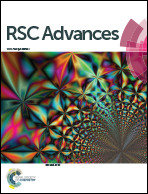One-dimensional nickel borate nanowhiskers: characterization, properties, and a novel application in materials bonding†
Abstract
The growth of nickel borate [Ni3(BO3)2] nanowhiskers was successfully achieved by simply heating a mixture of nickel and boron oxide (B2O3) powders at 950 °C in air. The products were characterized using X-ray diffraction, scanning electron microscopy, and transmission electron microscopy. The synthesized nanowhiskers, with diameters of 150–500 nm and lengths of 10–30 μm, possessed high aspect ratio, and were found to grow along the [012] crystallographic direction. Stacking faults, hollow interiors, and high-energy facets were found occasionally. The high-temperature stability of Ni3(BO3)2 nanowhiskers was investigated. The nanowhiskers partially decomposed after being treated at 1200 °C. Based on the solid–liquid–solid mechanism, the possible growth process of Ni3(BO3)2 nanowhiskers was discussed. Ni3(BO3)2 nanowhiskers were successfully used for bonding nickel in air. The nickel/nanowhisker/nickel joint was characterized in detail by scanning electron microscopy and laser scanning confocal microscopy.


 Please wait while we load your content...
Please wait while we load your content...